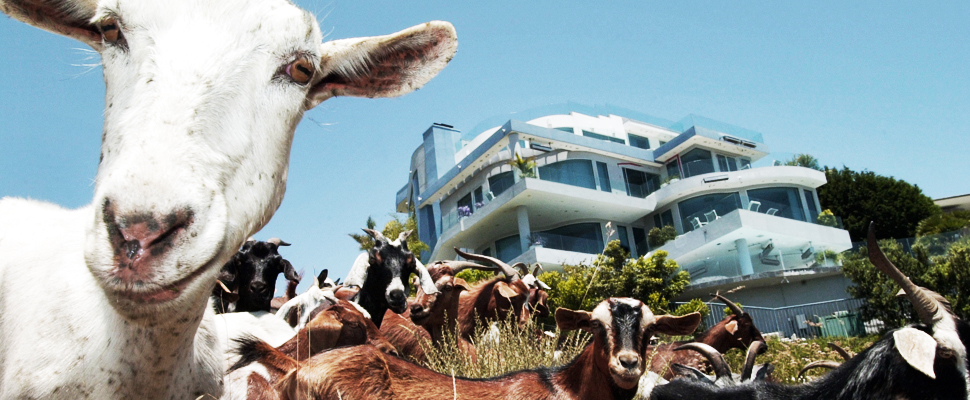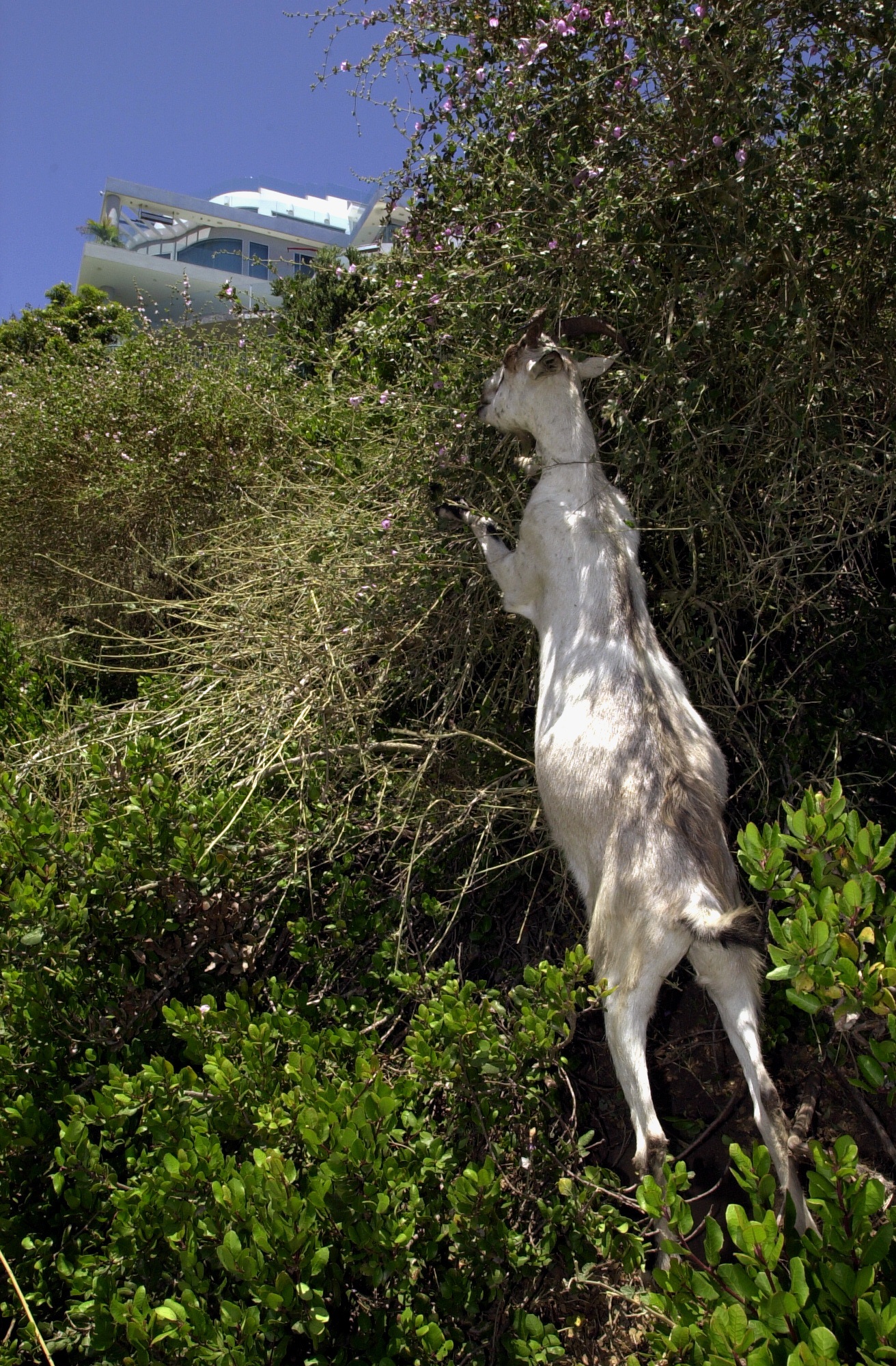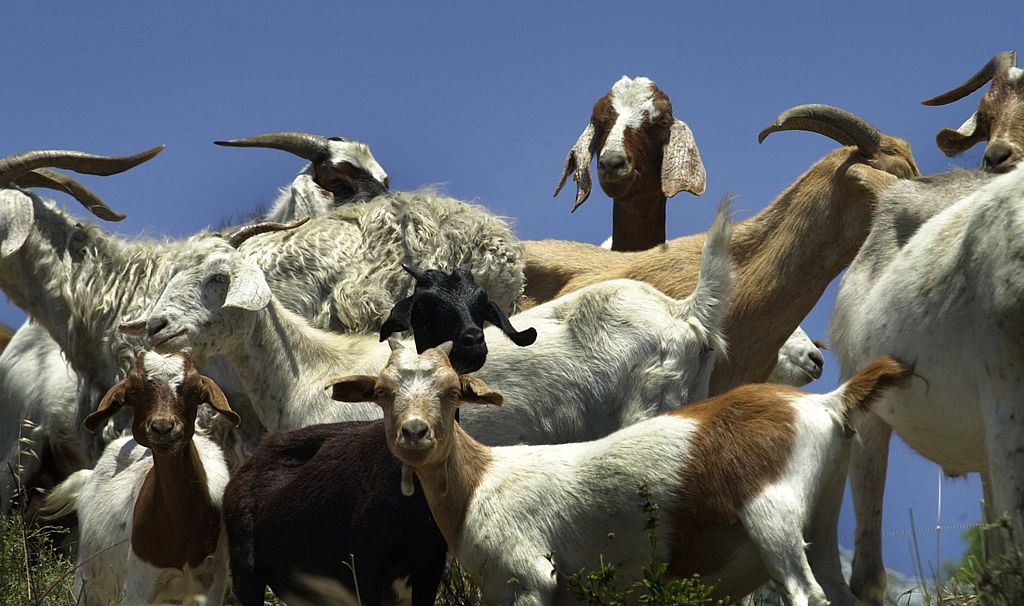
As the saying goes, not all heroes wear capes. Some run head first into a fire equipped with over 45 pounds of gear and live to tell about it.
Firefighters are heroes. No doubt about that. But they don’t all fit the “wearing flame-retardant gear to battle back flames” mold. Some are planners, working on long term prevention. Some are ecologists, trying to understand the large scale impacts that wildfires have on our ecosystems. And some… have horns, hooves, walk on four legs, and eat grass.
What we’re getting at is, not all firefighters are human at all. Some, it turns out, are goats.
Fire Departments all across California have been relying on goats to clear the type of brush that can act as devastating wildfire fuel every year for almost a decade. And the goats are so good at the job that one small town in California even set up a Go Fund Me campaign this year — cheekily named Goat Fund Me — to raise money to bring goats in to clear the brush on hundreds of wildfire-vulnerable city-owned acres.

The Smithsonian reports that “about 6,000 woodland fires sweep California annually,” and just last year, the Woolsey Fire made national headlines as it devastated Ventura and Los Angeles counties burning over 96,000 acres, destroying 1,643 homes and causing $500 million in damages. In southern California, the fire season is inescapable, Inspector Brian Stevens of the Los Angeles County Fire Department contends that “right now, wildfire season is considered year-round in the county of Los Angeles” which means every day that there isn’t a wildfire blazing in Southern California, is a good day to practice sensible fire prevention. In the summer months when the wild grasses are drying out, that means calling a herd of goats to munch away at potential fuel.
One of the reasons goats are so useful to fire departments statewide is their unique physiology, which makes them expert climbers, and their near-insatiable appetites.
“The goats work great for getting to inaccessible areas that are hard for equipment to reach,” explains Fire Captain in Charge of Vegetation Management for Ventura County, Ken VanWig. “Areas we can’t do prescribed burning because of possible structures nearby, or the threat of fire spread. They work great for rugged terrain that is difficult to maneuver with weed whips and hand tools. They’re very environmentally friendly, they work quickly. They eat, sleep, and eat, that’s really all they do.”
Though it’s not just agility that makes goats the preferred choice for firefighters, VanWig continues: “The reason we use goats as opposed to other animals like sheep, is that goats are a lot easier on the land, they don’t pull the roots out of the ground, they just chew them off at the ground level, which keeps the ground stable. Sheep pull the roots out of the ground or dig them up to eat them.”
According to an article from Research Gate, goats can munch on a variety of shrubs that would be considered useless to other domestic species like cattle, and seek out the invasive Mediterranean plantlife which have historically proven to be devastating fuel ladders that can make the harmless spark from a weed wacker quickly turn into a raging fire.
“Typically about 400 goats can do about an acre a day depending on how thick the vegetation is,” VanWig notes. “We mostly use them for grass fuels on areas we maintain annually.”
Using goat grazing as a means of fire prevention has also proven to be eco-friendly. Because goat grazing requires no fuel aside from the amount used to transport the goats to where they are needed, they’ve been shown to be self-sustaining and cost-effective. Goat-grazing can run between $800-$3000 per acre, depending on the accessibility, plot size, and water sources of the prescribed area.
Typically, the goats aren’t owned by the fire departments themselves. A department will instead contract the goats from goat herders — like the Gonzalez Brush Busters, The Goat Works, or City Grazing — once they’ve determined where brush clearance is needed. The herders will the transport a herd — typically numbering around 400 goats — and set up a portable fenced area fit for the size. Once the goats have sufficiently munched on the greenery to the fire department’s liking, the herders will fence off another area and the lead the goats to a new workload. “It’s like hopscotch, you just keep moving along through the area,” says VanWig.
Grazing is an effective, nearly carbon-neutral weed control technique, “goats are very clean animals,” VanWig says, “their digestive systems are so thorough that their droppings won’t reproduce seeds, so it helps to reduce invasive species, they’re very good at eating the invasives.” Best of all, they’re aesthetically pleasing. A grassland full of tractors and weed whips can cause noise and be a strain on the eyes of a city’s population, whereas a field full of goats doing what they do best is a win-win for everyone involved.
In this year alone, counties and cities like Laguna Beach, Ventura, Lemon Grove, Nevada City, San Rafael, West Sacramento, Lake County, Santa Rosa, and the Los Angeles Forestry Division have all used goats to munch on the quickly drying grasses across California wildland.
“To have people do what these goats do, to clear the amount they would do, would be financially impossible,” Laguna Beach Cheif of Fire Prevention Ray Lardie, told the LA Times.
Each year as global temperatures rise, California is met with increasingly intense wildfires so it is absolutely vital to eliminate any wildfire fuel sources that may further exacerbate the annual occurrence of wildfires. Goat grazing is just one important tool in the fight against California’s blazes. So much so that the next time you’re in the Golden State and you see a goat, you just may want to walk up and thank them for their service.







